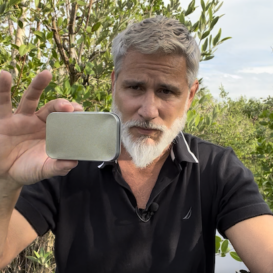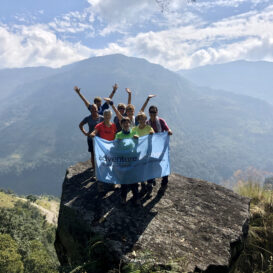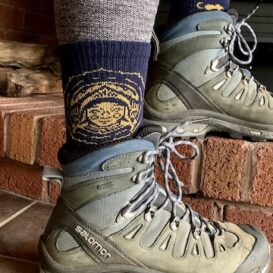Musa Masala is continuing our series on Search and Rescue and wilderness safety with this important post from Jason Tartalone.
Jason is the founder of Sergeant Rescue Training and Consulting, an EMS, SAR and wilderness medicine training organization located in State College, PA. Jason is sharing with us the concept of Preventative Search and Rescue. Basically through education and early intervention you never have to launch those SAR teams because the situation never develops.
Great idea right?? Well, we think so. We are all about you getting out there and staying safe and healthy, and that leads us to the introduction of our latest card in the Musa library. Please raise your hands and stomp your feet as we unleash…
Lost and Found, a quick guide on how not to get lost.
Available at our store and soon with all our friends who distribute our Musa Masala Educational Cards. This card joins our Altitude Tips Card, Heat Illness, and Hypothermia Card. Check them out here!

Side One: Steps to take to keep the surprises to a minimum.

We will pick apart each important point in this card in a future post, but let’s learn a bit now as Jason shares with us. Thanks, Jason. Jam Jam!!
Preventative Search and Rescue
By Jason Tartalone NRP, FAWM, FEWM, WP-C
Preventative search and rescue (PSAR) techniques for hikers are becoming increasingly important as a means of reducing the number of search and rescue missions in wilderness areas. These techniques focus on preparation, education, and information to help hikers avoid dangerous situations that could lead to needing rescue. Here are some key aspects of preventative search and rescue for hikers:
The importance of PSAR can not be understated. The National Park Service (NPS) alone spends nearly $5 million annually rescuing visitors. PSAR aims to reduce these missions and associated costs through preparation, education, and information in both the National Parks and local recreation areas. PSAR is a growing Concept nationwide, with parks like Little River Canyon National Preserve adopting and adapting PSAR to ensure the safety of their parks and visitors.
PSAR teams record interactions with hikers on trails, noting “general contacts” and “preventive actions” (advice given based on poor personal preparedness). The Yosemite Conservancy funds PSAR teams for education and outreach efforts during busy months, including managing information stations along popular trails, creating hazard-specific signs, and producing digital content for safety messaging. Other parks and many local SAR teams are beginning to focus on the “Hike Smart” campaign, advising hikers to plan their hike, remember to bring food and hydrate, establish an emergency action plan, pack the right gear, allow time for rest and recovery, be ready for changes in weather, engage in and observe surroundings, and dress appropriately.
The PSAR programs that exist today use a data-driven, evidence-based approach to identify and implement education, enforcement, and engineering strategies to reduce the number of search and rescue incidents. Daily patrol logs by PSAR staff at state and national parks help provide information for evaluating and refining strategies to prevent trail mishaps. Local teams are also using incident data to target groups and locations that have commonly gotten lost.
Volunteer programs play a significant role in PSAR efforts, with volunteers supplementing and amplifying outreach efforts. Community education and information dissemination are key components of PSAR, focusing on trail safety, proper equipment, and awareness of the environment. Training and seminars in hug-a-tree for kids and adults, leave no trace, and other training seminars help those that venture out be easier to locate if they get lost or injured.
Here are some key suggestions to help not become a statistic on your next long or short adventure!
1 Plan the hike and hike the plan – Many injuries and lost persons are due to venturing off the beaten path and not following a plan.
2 Once you make your plan tell someone! In this day and age of technology its easy to send a map, text with trail names, or places you intend to visit to a loved one, friend or family member.
3 Tell someone when you will be back! Then contact them when you are. This decreases the delay in response so that you are noticed as missing and overdue quicker.
4 Seek out basic training! The internet, youtube, and other sites are chalk full of basic navigation training, first aid training, and some hiking or back packing tips and tricks. Practice these things and learn about them before venturing out in the back country.
5 Carry and wear the essentials EVERY TIME!
- Good footwear – proper fitting and tied shoes or boots are essential for traction and support on the trail.
- Water – It is 100% a necessity on any short or long hike. We recommend at least 2 liters with you anytime you go out!
- First Aid Kit – A small first aid kit with some key items will save your trip and sometimes your life. We don’t want little nuisances to become major issues.
- Whistle – A fox40 can save your life. It makes a lot of noise to attract attention and requires minimal effort and energy to do so.
- Flashlight – We don’t always plan to be out at night. But having a headlamp with spare batteries is key if we end up in the dark.
- Layers – It’s a minimal suggestion to make sure you have some rain gear. However, depending on the time of year, having extra layers is key to being comfortable and safe.
- Sun Protection – Even on overcast days it is still possible to get sunburnt. This can make your trip less comfortable and then also damaged skin makes it harder to regulate your temperature.
- Snacks – Always have some trail mix, granola bars, or protein bars for some added energy!
- Backpack – There are many brands, types and designs out there today to suit your personality and back country needs. The key is having something that is able to carry all of your stuff and is comfortable for you.
PSAR efforts have led to a decrease in hiker assists and patrol hours in some areas, indicating improved hiker preparedness and awareness.
- The outreach and educational activities of PSAR teams have a measurable impact on reducing the number of hikers requiring assistance.
- Decreases the need for resources so they are available when needed.
- Then also if you do get turned around, they make you easier to locate and get you help quicker.
In conclusion, preventative search and rescue techniques for hikers are a vital component of ensuring safety in wilderness areas. These techniques involve a combination of education, planning, and community involvement to reduce the need for search and rescue missions. No one ever adds in their plan get lost or hurt today. However, this does not negate the need to be prepared and always be ready if that remote possibility does occur. A little bit of effort and training before you take your next adventure could very well save your life.

Jason Tartalone is the founder and owner of Sergeant Rescue Training and Consulting. He is a 12 year veteran of the U.S. Army where he served as a Combat Medic and Flight Paramedic in Afghanistan and other austere environments. He has been involved in wilderness search and rescue for 17 years. He is now a National Association of EMT Affiliate faculty member and is a member of the board of the National Association of Search and Rescue. Jason has and does so much, check out Sergeant Rescues website here for more on Jason and the programs they offer.













